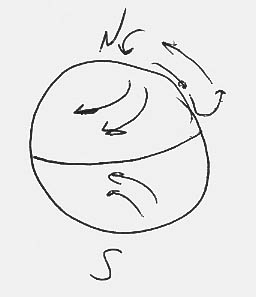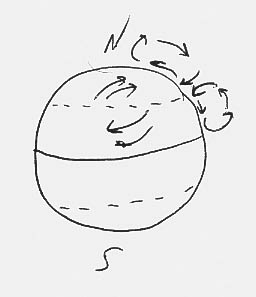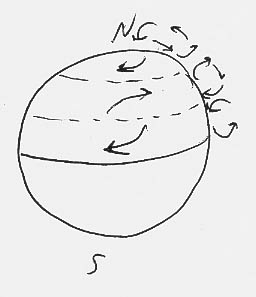
OCG123, Spring 2001
Answers to second hourly exam
Friday 2 March 2001, Chapters 4–6
Instructions:
Read over the entire exam first. Begin
with the questions you feel most confident about. Pace yourself so that you will
have time enough to try everything. If you don’t know how to get all the way
to an answer, go as far as you can and state how you would approach the rest.
And keep your handwriting neat! Use the back of the sheets if necessary. Show
your work so that I can give you all the partial credit you deserve.
Definitions (3 points each; 30
points total)
1. Hadley circulation—The process by
which an air mass undergoes convergence at the tropics and divergence at about
30 ºN or 30 ºS in
one large convection cell.
2. Coriolis effect—The tendency for
moving air or water to be deflected from its apparent straight-line path
rightward in the northern hemisphere and leftward in the southern hemisphere.
3. Monsoon—A seasonal reversal in
surface winds caused by large-scale differential heating of land and ocean
surfaces.
4. Latent heat—Heat energy released
or absorbed during the transition from one phase to another. Used here for
transitions of water.
5. Pycnocline—A relatively rapid
change in density with depth that marks the boundary between surface waters and
the deep ocean. Can be caused by changes in temperature, salinity, or both.
6. Ekman spiral—A systematic curling
of the direction of oceanic flow with depth. Caused by surface winds, friction,
and the Coriolis effect.
7. Geostrophic flow—A flow of air or
water caused by the balance of pressure force and Coriolis force. Clockwise in
NH and counterclockwise in SH.
8. Moho—Boundary between crust and
mantle. Speed of seismic waves increases rapidly there.
9. P wave—Primary seismic wave. The
seismic wave that is composed of compressions and expansions (rarefactions) in
the direction of propagation. Also known as longitudinal wave. Can travel
through solids and liquids.
10. Wilson cycle—The regular breakup
and reassembly of supercontinents. Its period is 500 years.
Short answers (5 points each; 40
points total)
1. Why are there so many deserts around
latitudes 30º N and 30º S? Use a diagram if you wish. 30º N and 30º S are
roughly the latitudes where air in the Hadley cells is descending. Descending
air warms and evaporates any clouds that might have been present (the opposite
of what ascending air does), and so creates latitudinal zones of cloud-free air
and abundant sunshine. The lack of rain and the intense sunshine combine to
create deserts.
2. Where do the temperatures vary more
with season, over continents or oceans, and why? Temperatures vary more with
season over the continents because they have a lower heat capacity than the
oceans. Part is the smaller heat capacity is due to the properties of rock, and
part is because the continents cannot carry the heat downward as easily as the
oceans can.
3. What is the polar front, and how do
storms form along it? The polar front is the place where warm, moist air from
the tropics meets cool, dry air from higher latitudes. Storms form as a
disturbance destabilizes the two columns of air and the denser cold one moves
under the lighter warm one. This lowers the center of gravity of the system and
trns potential energy into kinetic energy (the energy of the storm).
4. Explain the differences in driving
forces for surface circulation and deep circulation in the oceans. The
surface circulation is driven by the surface winds, the deep circulation by
dense water sinking.
5. Name the two major places where bottom
water formed? What makes it? Bottom water is formed near Greenland in Iceland
in the north and in the Weddell Sea in the south. The water is made so dense by
cooling by salt being released from the sea ice that is forming at the surface.
6. Explain briefly how geostrophic flow
reinforces the flow in the North Atlantic gyre that is created by surface winds.
Use a diagram if it will help. The clockwise surface winds and the associated
Ekman transport at depth direct water toward the center of the North Atlantic
gyre, where it piles up. The surface of this water then runs off toward the
sides, during which the Coriolis force deflects it to the right and in
conjunction with the pressure force creates clockwise flow that reinforces the
clockwise flow from the winds.
7. List and briefly explain the various
possible sources of heat for the outer core. (1) Radioactive decay. (2)
Residual heat from collisions with asteroids, etc., as the earth was being
formed. (3) Gravitational energy released as the heavier matter sinks to form
the core.
8. What creates the earth’s magnetic
field? The circulation of molten iron in the outer core. The circulation is
driven by the heat of the inner core.
Problems and longer answers (10
points each; 30 points total)
1. Use diagrams to derive the earth’s
three-celled atmospheric circulation. Be sure to show why one cell and two cells
don’t work. (1) The one-celled circulation produces friction that would
slow down the earth, which cannot be. (2) The two-celled circulation can balance
out the frictional effects, but creates rising air at the pole or sinking air at
the equator, both of which are impossible. (3) The three-celled circulation
balances the friction and allows the air to rise at the equator and sink at the
poles.

The one-celled circulation on a rotating earth.

The two-celled circulation on a rotating earth.

Three three-celled circulation on a rotating earth.
2. Use the three components of relative vorticity and their changes with
location to explain the asymmetry of the North Atlantic gyre. You may use a
diagram to help. (See Box Figure 5-1 in the book.) On the west side of the
gyre (near Florida), the positive vorticity from friction with the continent
must offset the decrease in vorticity from moving north and the decrease in
vorticity as the water begins to rotate clockwise. The was to increase the
frictional component is to speed up the water, narrow its path so that more of
it interacts frictionally with the continent, and deepen it for the same reason.
On the eastern side of the gyre (Europe and Africa) the positive vorticity from
friction need only balance out the difference between the increasing vorticity
from moving south and the decreasing vorticity from turning clockwise at the
edge of the continent. Thus the friction has to do a lot less, and so the
resulting current can be slow, wide and shallow.
3. List and describe the chain of
influences inside the earth that lead to plate tectonics (drifting continents).
Start from the core, progress up through the mantle, and pass through the
asthenosphere to the continental and oceanic crust. Use a diagram if it will
help. (1) The hot core heats the bottom of the overlying mantle and
destabilizes it, just as heat at the earth’s surfaces destabilizes the lower
part of the troposphere. (2) In response to the heat, rock in the mantle
convects slowly in closed “vertical” cells. (3) The top of these convection
cells pulls plates horizontally. (4) The plates float on the top of the
asthenosphere.